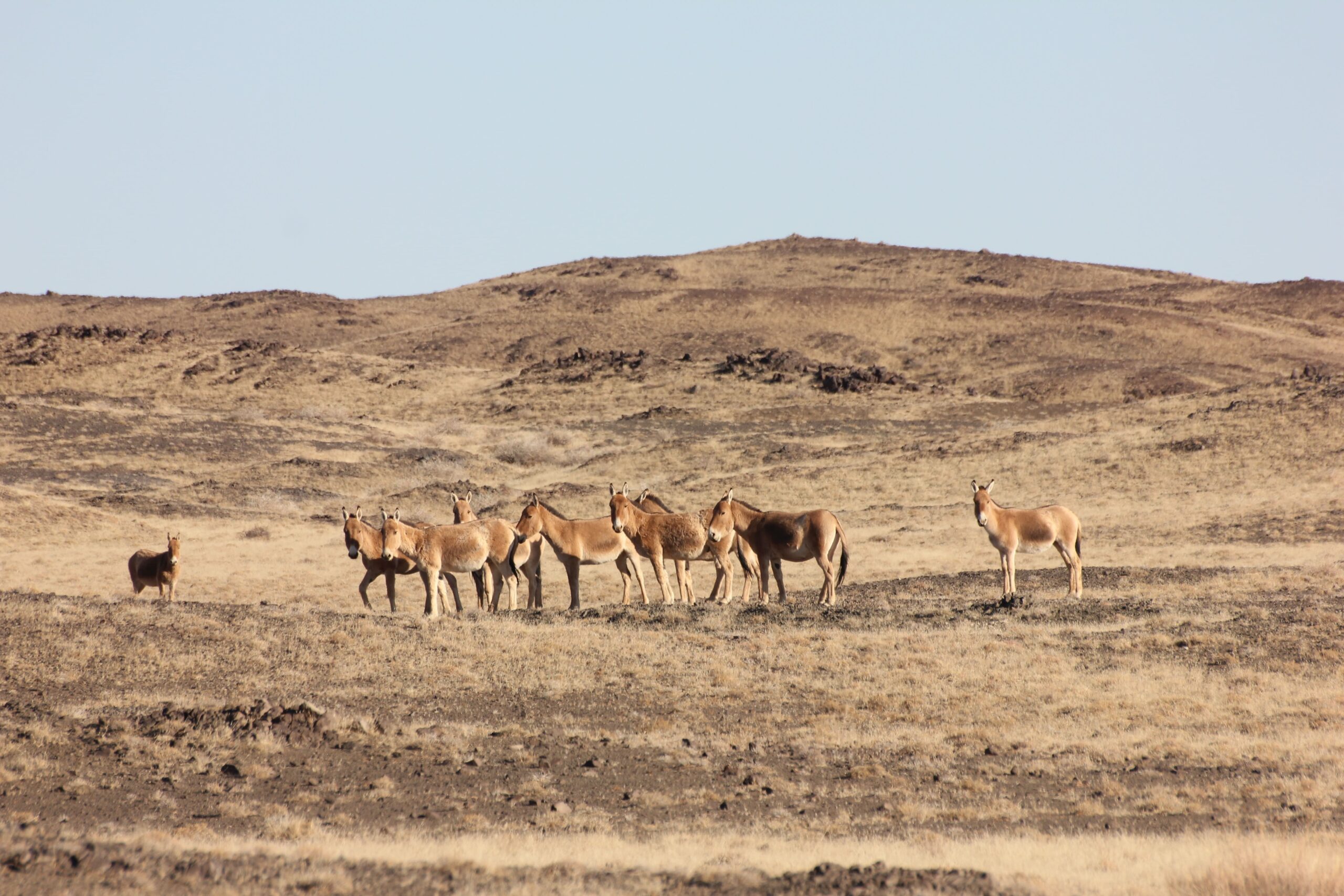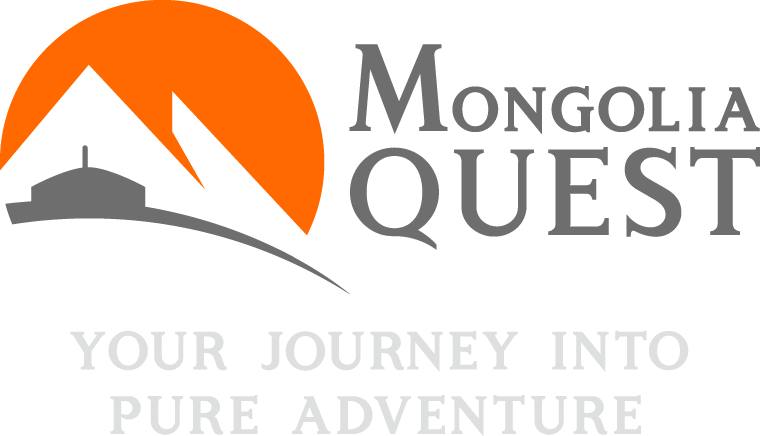In the vast expanse of Mongolia’s Gobi Desert, a critical conservation effort is underway. The Khulan, or Asiatic wild ass (Equus hemionus hemionus), has roamed these lands for centuries, playing a vital role in maintaining the delicate balance of this unique ecosystem. As one of the last great wild herbivores of the desert, the Khulan is essential for the survival of the Gobi’s biodiversity. However, their future is under threat.
These animals are more than symbols of Mongolia’s wilderness; they are key engineers of the desert landscape. Through their migrations and grazing patterns, they help sustain plant diversity, open up water sources, and maintain pathways for other wildlife to survive in this harsh environment. Without their presence, the Gobi ecosystem could face irreversible changes.
What’s at Stake: The Gobi’s Ecosystem Engineer
Khulans have an incredible ability to traverse vast landscapes. According to recent research, the distribution area of Khulans spans 360,000 square kilometers worldwide, with Mongolia making up 72% of this range. Every year, Mongolia’s Khulans migrate over 70,000 square kilometers, making them the land animals with the greatest migration distance on the planet. These movements prevent the overgrowth of vegetation, maintain plant diversity, and ensure the survival of other species in the desert, from small rodents to apex predators like the snow leopard.
Scientists and locals have nicknamed them “Gobi Well Engineers” due to their remarkable ability to carve out paths to water sources during their long migrations. This benefits the khulan themselves and aids other desert species and even humans. They are known for digging water holes into the Gobi soil with their front hooves, Khulans access underground water, creating vital wells that serve as drinking sources for both them and other animals.
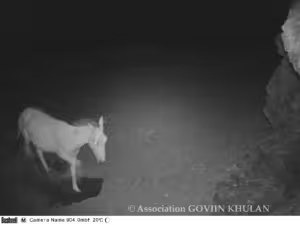
Khulan Digging Water Hole captured on Trap Camera ( Credit: Goviin Khulan Association)
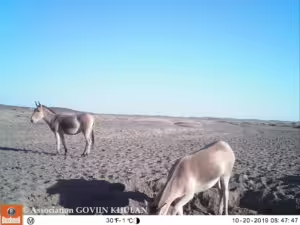
Khulans drinking from Water Hole captured on Trap Camera ( Credit: Goviin Khulan Association)
The Gobi Great Six: A Rare Assembly
When people think of the Gobi Desert, they might imagine barren dunes and harsh survival. But life thrives here in astonishing forms. The Khulan is part of the “Gobi Great Six,” an elite group of wildlife species that represent the resilience and diversity of this land. Alongside the Khulan, you’ll find the Bactrian camel, saiga antelope, goitered gazelle, the takhi(wild horse), and the elusive Gobi bear—also known as the Mazaalai. Each of these species plays a vital role in the Gobi’s delicate ecosystem. Together, they weave a complex web of life, where the survival of one often supports the survival of others. But like the Khulan, these species are under siege.
The Reality: Why the Khulan is Running Out of Time
As of 2023, it’s estimated that fewer than 100,000 Khulans remain in the wild, with Mongolia home to an estimated 89,000 individuals, which represents 80% of the world’s total population(CMS,GIUM Fact Sheet). This might sound like a decent number, but it’s far from stable. Human activities—mining, livestock farming, and infrastructure projects—are fracturing the Gobi Desert, cutting off the Khulan’s ancient migration routes and limiting their access to water sources.
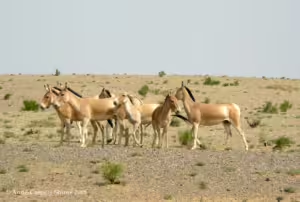
Water, the lifeblood of all living things, is becoming scarcer in the Gobi. Climate change has reduced rainfall, and the Khulan must now compete with livestock for access to shrinking water sources. In the past decade, Khulans have become increasingly isolated, their populations fragmented by new roads, railways, and mining projects. According to WCS Mongolia, “Khulan are now listed as an endangered species on the IUCN Red List and scientific evidence suggest that abundance has declined globally by more than 50 per cent over the past two decades (Moehlman et al. 2008). They are also included in Appendix I of CITES, and Appendix II of CMS.”
The international market for Khulan meat and hide also persists, making poaching a continuous threat. Despite legal protections, poaching still claims the lives of hundreds of Khulans each year. Each loss is a blow not just to the species but to the ecosystem they support.
What Can Be Done: A Global Responsibility
This is not a fight the Khulan can win alone. Fortunately, Mongolian organizations and international conservationists are stepping up. The Goviin Khulan Association, in partnership with local communities, has been working tirelessly to monitor Khulan populations, preserve water sources, and crack down on poaching activities.
Recent projects have focused on community-driven solutions, where local herders, communities’ members, and rangers collaborate to maintain safe migration routes for Khulans, protect natural resources, and collect and share data with international research groups, thus being empowered as ‘Gobi Guardians of Nature for people and wildlife to thrive and coexist in harmony’.
In addition, the Goviin Khulan Association is also working towards bridging local environmental knowledge to scientific environmental knowledge and developing capacity building of protected areas’ rangers and local communities’ leaders to enhance protection of vital water sources and Gobi landscapes on the long-term.
But the work requires more than just research. The involvement of eco-conscious travelers and global citizens is critical. By raising awareness, supporting responsible tourism, and contributing to conservation efforts, we can all play a role in safeguarding this magnificent species.
How You Can Help Protect the Khulan
Here at Mongolia Quest, we believe that travel has the power to protect. Our “Meeting & Protecting Gobi Khulan” tour offers a unique opportunity to not only explore the stunning Gobi Desert but to contribute directly to the Khulan’s survival. This is more than an adventure—it’s a chance to make a difference.
On this tour, travelers join experts from the Goviin Khulan Association and locals for an immersive experience, learning about the Khulan’s behavior, tracking their movements, and visiting critical water sources that are vital to their survival. Guests gain firsthand insights into the challenges facing these animals and how local and international efforts are helping turn the tide.
A portion of each booking directly supports conservation projects, including water resource management and anti-poaching measures. Your travel funds field research and supports the incredible work being done to protect not just the Khulan but the entire Gobi ecosystem.
To learn more about the Khulan’s conservation and the Goviin Khulan Association, visit their official site here: (www.goviinkhulan.org). You’ll find additional resources, updates on current projects, and ways to get involved.
Follow their journey on Instagram:
Will You Join the Conservation?
The Khulan’s future depends on the choices we make today. By traveling with a purpose, spreading awareness, and supporting conservation, we can all be part of this remarkable animal’s story—one that stretches back through millennia. Let’s ensure the Khulan continues to thrive in the Gobi Desert for generations to come.
Ready to make a difference?
Book our “Meeting & Protecting Gobi Khulan” tour today and be part of Mongolia’s conservation story.
Related Resources:
- Goviin Khulan Association
- UN Environment Programme: Protecting Asian Wildlife
- Mongolia’s National Biodiversity Plan
- Badamjav, Lkhagvasuren & Reading, Richard & Mix, Henry & Feh, Claudia & Kane, David & S.Dulamtseren, & Enkhbold, Sumyain. (2001). Status and distribution of khulan (Equus hemionus) in Mongolia. Journal of Zoology. 254. 381-389. 10.1017/S0952836901000887.
- Global Initiative on Ungulate Migration Khulan Fact Sheet,2023
- WCS Mongolia

